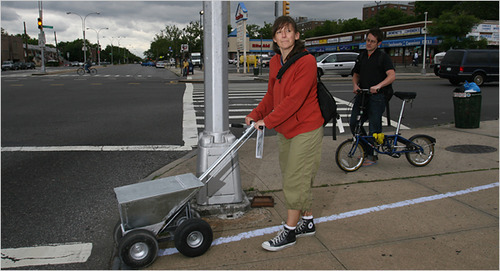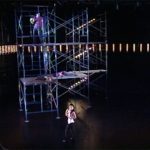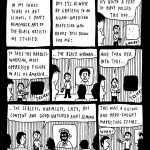The Business of Art: Art as Intervention (A Roundtable)
Eve Mosher: Why do all of you do what you do—and what role do the arts have in advocacy in the public realm?
Xavier Cortada: I create participatory eco-art projects to challenge us to explore our connection to one another and the natural world. In many ways, we [artists]are conveners, bringing people into a dialogue to help them think about things they may not have been focusing on. Through this process I hope the art that I create is a catalyst for action and social change.
Brooke Singer: The work I do is also about creating opportunities/platforms to learn, reflect, discuss, and—ultimately—act upon some of the most urgent issues of our time.
For example, a current project of mine, Superfund365, A Site-A-Day, is an online data-visualization application with an accompanying RSS-feed and e-mail alert system (www.superfund365.org) that visits one toxic site active in the Superfund program run by the U.S. Environmental Protection Agency (EPA) each day for a year. In the end, the online archive will consist of 365 visualizations of some of the worst toxic sites in the U.S., roughly a quarter of the total number on the Superfund’s National Priorities List (NPL). Along the way, I am writing an e-mail update with highlights and conducting video interviews.
I am using common features of wikis and blogs so that user content and local knowledge can co-mingle with the official data of the EPA. The project also becomes a general platform to discuss the impacts of industrial and military processes on our health and local environments. Common contaminants are explained and responsible parties exposed.
The other day I heard someone say that “art can be very loud” — which is a nice way of noting how provocative, resonant, and, therefore, effective it can be, especially in the public realm (meaning outside of the museum/gallery space). Art makes openings for people to interact in new ways that are vital in our media-saturated, individuated, and commodity-driven world.
E.J. McAdams: When I was a New York City Urban Park Ranger there were not many resources on urban nature. One of the few was the book Concrete Jungle, edited by artists Alexis Rockman and Mark Dion. In it Dion had made a diagram of an urban food web, which integrated (and thus valued) the wildlife I most often saw in the city (rats, pigeons) as well as more traditional wildlife (hawks, raccoons, owls) that one more commonly finds in field guides. Rockman and Dion, and the other artists they describe in their book, pioneered a new way of looking and opened pathways that educators, scientists, and ultimately politicians could follow. The renewed interest in urban ecology, landscapes, and parks come in part from this artistic movement. As everyone knows, what we don’t value we won’t protect. Often it is artists who point out something of value that others have forgotten or else hadn’t noticed
I’m on the board of the interdisciplinary Laboratory of Art, Nature, and Dance (iLAND;www.ilandart.org), founded by choreographer and dancer Jennifer Monson. One of our main programs is iLAB, a residency that brings together movement artists and scientists/ecologists to develop a collaboration. As part of the residency, artists and scientists must engage with the public in some way. Oftentimes this has been a walk where participants are asked to focus on something they might normally ignore, like the soundscape or the “weeds.” This refocusing of the public’s attention is so important.
What I loved about Eve’s public art project HighWaterLine was that she took something anyone could see online at the Office of Emergency Management, the flood line, and then literally “drew” that line on the landscape. By focusing home owners and citizens on this line—the oldest artistic gesture—she initiated a discussion that has tremendous political possibilities.
But is being a convener enough of an action, and is it the best role of an eco-artist? In my view the critical role of the artist is the act, the act that redirects attention. Xavier’sReclamation Project has that same kind of power. It reminds people of the past in an intriguing visual way with his mangrove seedlings, while at the same time presenting a possibility for future action by restoring native fauna destroyed by the housing boom in Florida.
The eco-art I like has an interesting aesthetic gesture/intervention as well as some lasting ecological outcome, or at least one or the other, but much eco-art fails at creating either. Convening does not seem artistic; it is important, obviously, and will have a positive outcome for our work and hopefully for the globe, but I don’t think anyone would call it art.
Eve Mosher: Convening has a value if the art project is both compelling and participatory. Without artistic translation to add to this level of interest, then it more closely resembles the role of institutions. Artists have a certain amount of responsibility when they take on specific issues. They must provide a creative interpretation of an idea and also take on a broader responsibility of providing tools and resources for the project to live beyond our intervention. Where this kind of work fails is when there is not an artistic translation or a longer-lasting impact.
One of the most important aspects of this kind of work, as Brooke noted, is the idea of discussion. Because artists approach these complex issues from a role outside of the science community, we are capable (through our projects and presence) to potentially open up broader discussion. Art has the ability to distill or translate complex data and can provide points of entry, act as a catalyst, and/or provide a sense of involvement.
E.J. said that “often it is artists who point out something of value, that others have forgotten or else hadn’t noticed.” Artists often do this in a way that engages valuable audiences, including the media. The issues are not necessarily new or unheard of (often they are already covered in the media) but we are creating compelling stories or tools that make the issues easier to understand (or present them in a compelling manner).
The power of work by Xavier, Brooke, and myself is that we are taking it into the streets (or putting it up on the Web) and engaging a broad and not self-selected audience. To use E.J.’s words, we often use the elements of surprise or curiosity to “refocus people’s attention.”
BS: I agree that being a convener is not enough of an action; convening is never an end in itself but rather it is a means. It sounds like most of us organize these get-togethers for the purpose of frank conversation, information sharing, and/or alongside action. Convening is of course nothing new in the art world (Happenings come to mind) and at the most basic level we say "conveners” as a way to easily distinguish ourselves from the more prevalent and traditional role of the artist as object-maker.
For us to say that we are artists, and therefore our convening is going to be inherently different from institutional convening (conferences, meetings, plant-a-tree day), may seem obvious to us, but it’s probably not compelling or a complete answer for an outside audience.
And to end on a different note, lately I have been thinking about the radical nature of information sharing. Radical, but why? Why am I compelled to circulate, digest, reinterpret, and discuss information in my artwork? That we are in an information age is so misleading, so false—that because we have access to the Internet and digitized libraries and smart phones we are somehow better equipped to understand, make choices, and act upon those resources. So what is effective information sharing and what does a true information age look like?
EJM: In my work with bird conservation, a colleague used to say that the way to grassroots success was “endless pressure, endlessly applied,” and I wonder if an artist can sustain that kind of effort and attention to an issue—or even want to—in their work. From looking at your various projects, I see commitments to openness, bringing hidden information to the fore, democratic convening, DIY, and aesthetically challenging and beautiful work, but applied to a whole suite of issues that could each use constant attention—and pressure.
So I guess it brings me back to the question of the “art” in all of this. Obviously this is a question without an answer but I want to challenge Eve’s definition that she brought up: “Art has the ability to distill or translate complex data and can provide points of entry, act as a catalyst, and/or provide a sense of involvement.”
You could change the word art to propaganda or marketing and the definition would still stand. In a world with so much information, as Brooke notes, how does the artist distinguish him or herself as a different voice? Or does the artist subversively work within marketing and propaganda using the styles of that discourse? How do non-artists spot the artist? Do we have to trust the artist because they say they are the artist, that they are not marketeers or ministers of information? It sounds like these questions are already a part of your personal dialogues with one other.
I’d like to end with a quote from the poet George Oppen. Oppen was born in 1908 and was politically conscious his whole life; he even stopped writing to exclusively devote himself to activism and his family. This is from his Selected Prose, Daybooks, and Paper:
“I think the question asked more frankly would be: is it more important to produce art or take political action. Of course I cannot pretend to answer such a question. I could point this out, however, that art and political action are in precise opposition in this regard: that it can always be quite easily shown that political action is going to be valuable; it is difficult to ever prove that political action has been valuable. Whereas art is precisely the opposite case; it seems always impossible to prove that it is going to be valuable, and yet it is always quite clear that the art of the past has been of value to humanity. I offer it only as a suggestion that art lacks political action, not action. One does what he is moved to do.”
I like this quote because it gets down to the nugget that one does what one is moved to do. That will be our motivation coming off this exchange.
BS: I’ll offer two responses: Art is tactical and nonprofits are strategic. It’s very difficult for artists (individuals or art groups) to sustain and apply endless pressure. But there are benefits to acting fast and freely, without the constraints that come with institutional titles, tax categories, and executive boards. Nonprofits benefit from these structures, as E.J. indicates, and in the face of corporate power or longstanding status quo, persistence and longevity are essential for change. But there are certain risks that a nonprofit will not take, and their function is prescribed by a mission statement.
Artist and nonprofit pairings can be very effective, but even though they may be simpatico, they are not interchangeable. We (my collective Preemptive Media) were contacted by the ACLU and approached by EPIC while doing artwork on the topic of data surveillance. Through working with these two groups, we accessed a new audience (and gained some legitimacy) but most importantly they provided us with solid research and tools from which to craft our work. I think that to them we were exciting and fresh, and a new way to get the message out.
EJM: I think that the distinction of tactical and strategic is very apt, and clarifies for me much of what we have been talking about.
EM: I often think about how to achieve measurable or long-term affects with the work I create (this is partly my own interest and partly due to grant applications/reporting). It’s not easy, as E.J. points out, and individual artists or even small collaboratives rarely have the capacity to maintain necessary pressure over time. However, as you’ve also pointed out, that may often be achieved by creating links to existing organizations. We don’t need to create new nonprofits; we need only to connect the nonprofits to the audience we are reaching, or give that audience the tools to connect to nonprofits. Or, in an ideal situation, provide tools for the audience to take matters into their own hands and exert that necessary pressure themselves. I work with both goals in mind, which also leads back to the information age. The Internet has opened up the power of these tools as they allow a larger audience to both convene around a project and become informed.
A quick note on the question regarding marketing versus art—I think the two are constantly borrowing from each other. I think the other thing that’s different, at least with the artists in this conversation, is that the marketer, and sometimes the “experts” are more interested in doling out information, and the artist is interested in being a catalyst for the conversation.
XC: I’m working hard at selecting, inspiring, and orienting [community] board members [for the Reclamation Project], as well as setting goals, creating donor structures, writing protocols for working with volunteers, developing partnerships with regulatory groups, growing the website, supervising interns, and managing my relationship with the nonprofit Miami Science Museum. Hardly the stuff of an artist, or is it?
As first blush, it certainly feels a lot like the kind of work I did straight out of law school as a community organizer in Little Havana, except there were no websites back then. It’s coalescing people around an idea, it’s building systems to move forward. It feels like I’m building a nonprofit, or implementing a campaign or a marketing effort.
But it’s bigger than that. It’s different. The purpose is different: The goal is not about having us change what we do (action) or how we do it (teaching). It’s not even about changing what we think (advocacy). It’s about changing how we see.
I think artists help do that in society. They observe and experience their world, doing so with a certain sensitivity or informed perspective. After processing what they’ve absorbed they share that with others in the hope of reframing the way they see things.
As an artist, I’m inspiring individuals (mostly volunteers who aren’t that involved in environmental issues and don’t know much about mangroves) to engage in the project. Sure, some participants will choose to act, to reforest, to elect the right kind of policymakers, to effectuate social change, to bioremediate—all stuff I am passionate about. But this is stuff that I could do as a faculty member or practicing law. Instead, I am seeking a different kind of social transformation—one that has one looking inward before pushing outward.
Also, as an artist I have the ability (and flexibility) and responsibility to continuously innovate. And constantly question. In many ways, that is what differentiates art—even political and activist art—from propaganda (or marketing). Propaganda is all mouth. It’s about loud one-way communication. No feedback loop, no concern for introspection.
Art is reflective. It is mostly about sensory coming in. It is most inspired when it listens, absorbs. It’s got ears, eyes, and a brain. Propaganda is all mouth. One loud gaping mouth spewing out.
If anything, participatory art heightens the divide between art and propaganda. It creates a vehicle for people to engage and challenge each other in this responsive artistic pursuit. It allows people to reflect and think, and see themselves differently.
During summer 2008, NYFA-sponsored artist Xavier Cortada will travel to the North Pole to create site-specific installations that explore our connection to the natural world. The work will include the reinstallation of works created at the South Pole in 2007. He will also create a series of “Arctic Ice Paintings” similar to those he made last year with melting Antarctic glacial and sea ice. Cortada’s Antarctic “ice paintings” are currently on display at PeabodyEssexMuseum’s Polar Attractions exhibit in Salem, MA. See www.cortada.com as well as www.reclamationproject.net andwww.nativeflags.org.
E. J. McAdams is on the board of the interdisciplinary Laboratory for Art Nature & Dance (iLAND) and has worked in the environmental movement for over a decade. He is a poet and his chapbook 4×4 was recently published by unarmed journal.
Eve Mosher received international media attention for HighWaterLine, a public art project that traced the predicted frequent-flood zone from climate change around 70 miles of New York City coastline. She recently launched Insert ____Here, a global project encouraging local optimism regarding to environmental issues. She is also currently developing Seeding the City, a network of green roof modules in neighborhoods to investigate collective action. More information is available atwww.evemosher.com, www.highwaterline.org, www.insert-here.org, andwww.seedingthecity.org.
Brooke Singer is a digital media artist living in New York City. Her work seeks to provide public access to important social issues that often are characterized as specialized or opaque. She is currently assistant professor of New Media at PurchaseCollege, StateUniversity of New York, and cofounder of the art, technology, and activist group Preemptive Media, www.bsing.net/blog. For more information on Brooke Singer, go to www.bsing.net.





